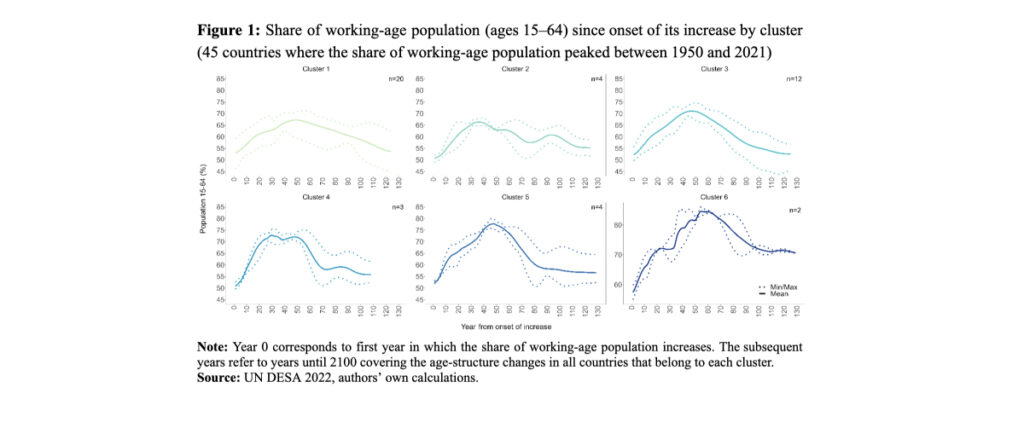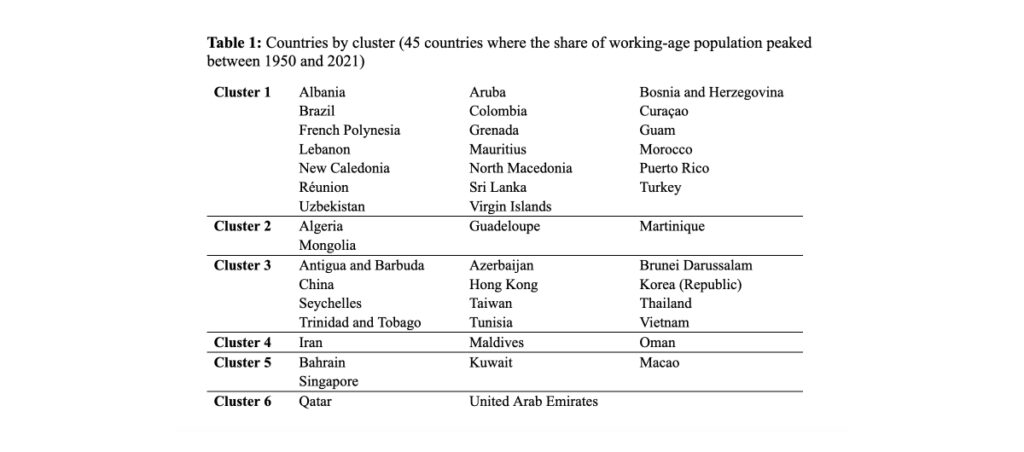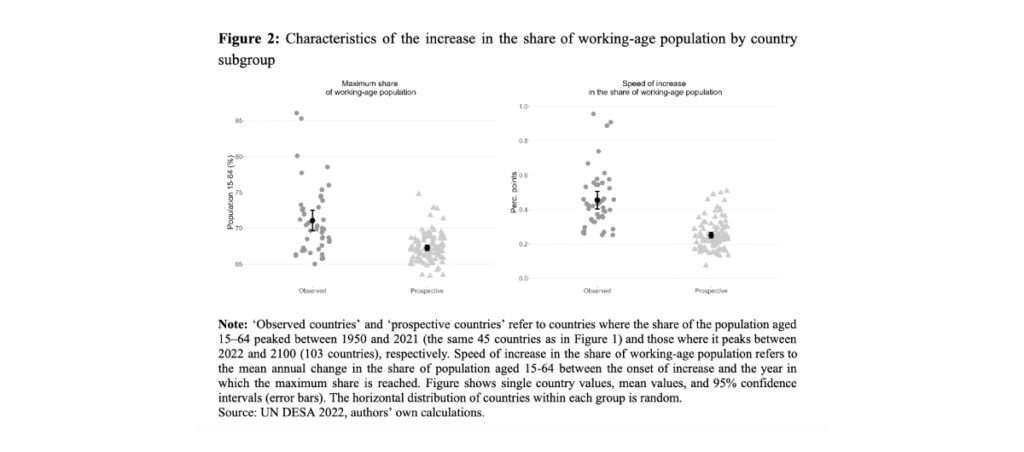The demographic dividend describes the economic growth potential based on shifts towards a larger share of working-age population when fertility declines in the course of the demographic transition. Markus Dörflinger and Elke Loichinger’s global analysis from 1950 to 2100 reveals notable differences – associated with fertility, migration, and population momentum – in the patterns of change in the share of working-age population across countries.
Demographic transition describes the universal process of declining mortality and fertility, which results in age structure shifts towards an increasing share of working-age population (ages 15–64). The potential economic benefits deriving from a large share of economically active individuals are referred to as the demographic dividend (Bloom et al. 2003). This concept is now widely used in development cooperation. Based on the experience of Asian countries, such as the so-called tiger states Hong Kong, Singapore, South Korea and Taiwan, changes in age structure – in combination with investments in education and health, infrastructure, good governance, and productive employment opportunities – are expected to be important drivers of economic growth and development in countries where the demographic transition is still less advanced (e.g., in countries in sub-Saharan Africa).
Given this expectation, in a recent article (Dörflinger and Loichinger 2024) we investigated past, present, and future global patterns of change in working-age populations. How uniform are these changes across countries? Which demographic factors are associated with them and what does this imply for the prospect of reaping demographic dividends in the future?
Similarities and differences in age structure changes
Changes in age structure are not as uniform across countries as sometimes expected. Rather, distinct patterns of changes in the share of working-age population can be found. A large proportion of countries where the share of working-age population has already peaked are now showing patterns that deviate substantially from the prototypical one, which draws upon the experience of selected Asian countries (Figure 1 and Table 1, Cluster 3). In many countries, the share of the working-age population increased more slowly and for longer, eventually reaching lower relative maxima (Clusters 1 and 2), while in a set of Asian countries (e.g., countries of the Gulf Cooperation Council, Iran, and Singapore) even faster increases and/or higher maximum shares of working-age population have been observed (Clusters 4 to 6).


In contrast to the countries analyzed above (referred to as observed countries), where the proportion of the working-age population is already declining, in over 100 countries worldwide, the proportion is still projected to increase (further) (prospective countries). Hence, these countries still have the potential to reap the benefits of a demographic dividend. However, in most of them, the share of their working-age populations is likely to increase more slowly and for longer, and to reach a lower maximum (Figure 2). This is particularly the case in countries of sub-Saharan Africa and Oceania. As the potential for a demographic dividend also depends on these factors, the potential economic benefits due to age structure changes may be smaller in these countries (Eastwood and Lipton 2011; Kotschy et al. 2020; Mason et al. 2017).

Associated demographic factors
Changes in the share of working-age population in the course of the demographic transition are mainly attributed to three factors. First, fertility level and the speed of fertility decline play a key role. For instance, fast fertility declines have contributed to rapid and high-peaking increases in the share of working-age population in Eastern and Southeastern Asian countries. In many sub-Saharan African countries, instead, fertility rates are projected to decline much more slowly, also decelerating subsequent age structure changes.
Second, migration can have an impact on the age structure. For instance, some of the countries that experienced exceptional peaks in the working-age population in the past, such as the United Arab Emirates and Qatar, are high-immigration countries. Conversely, emigration can reduce the proportion of working-age individuals.
Third, population momentum seems to slow down increases in the share of working-age population. Population momentum describes the effect of cohort sizes on population growth and age structure changes. For example, if the number of births per woman decreases but population momentum is high and the number of women of childbearing age increases, the total number of births does not necessarily decrease. Hence, shifts towards a large working-age population are slowed down. Population momentum is particularly pronounced in countries where fertility is still relatively high.
Implications for policy makers
Given these remarkable differences in the patterns of age structure change, it is essential to pay attention to the specific demographic situation of each country to properly assess the circumstances that will optimize the potential benefits of the demographic dividend. The positive experiences of selected countries in the past may not be replicable elsewhere in the future. Moreover, it is crucial for development planners of national and international organizations and local decision makers to understand the associations between age structure and fertility decline as well as the role of migration and population momentum in this context. These associations should be kept in mind when discussing the role of demographic developments for economic growth through the demographic dividend. Otherwise, the importance of fast fertility declines for age structure changes may be misjudged and the potential for development and economic growth may be overestimated.
References
Bloom, D.E., Canning, D., and Sevilla, J. (2003). The Demographic Dividend: A New Perspective on the Economic Consequences of Population Change. Santa Monica: RAND Corporation.
Dörflinger, M., and Loichinger, E. (2024). Fertility decline, changes in age structure and the potential for demographic dividends: A global analysis. Demographic Research 50(9), 221-290.
Eastwood, R., and Lipton, M. (2012). The Demographic Dividend: Retrospect and Prospect. Economic Affairs 32(1): 26-30.
Kotschy, R., Suarez Urtaza, P., and Sunde, U. (2020). The demographic dividend is more than an education dividend. Proceedings of the National Academy of Sciences 117(42): 25982-25984.
Mason, A., Lee, R., Abrigo, M., and Lee, S.-H. (2017). Support Ratios and Demographic Dividends: Estimates for the World. New York: United Nations (Technical Paper No. 2017/1).
UN DESA (2022): World Population Prospects 2022, Online Edition. New York: United Nations.


